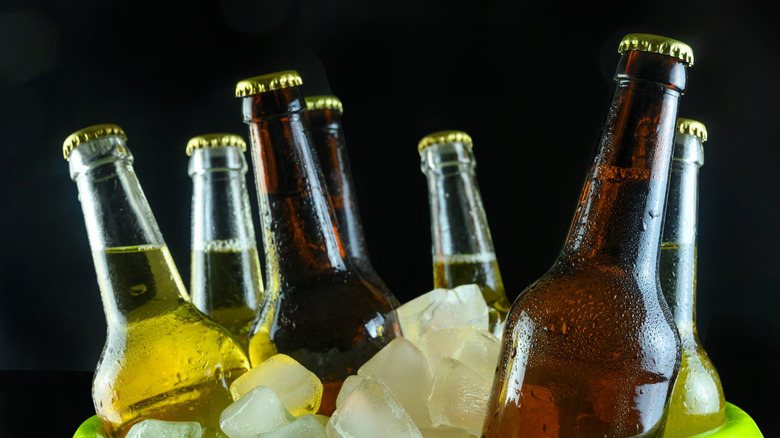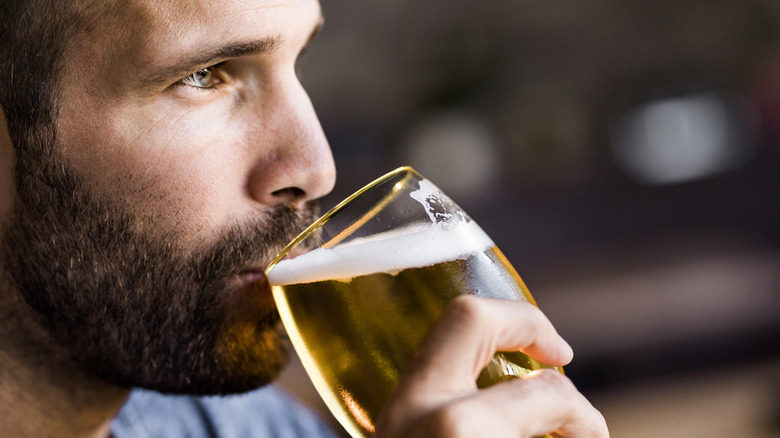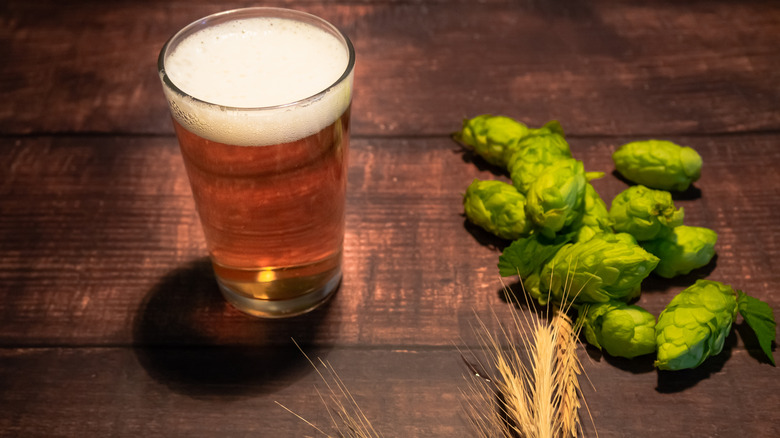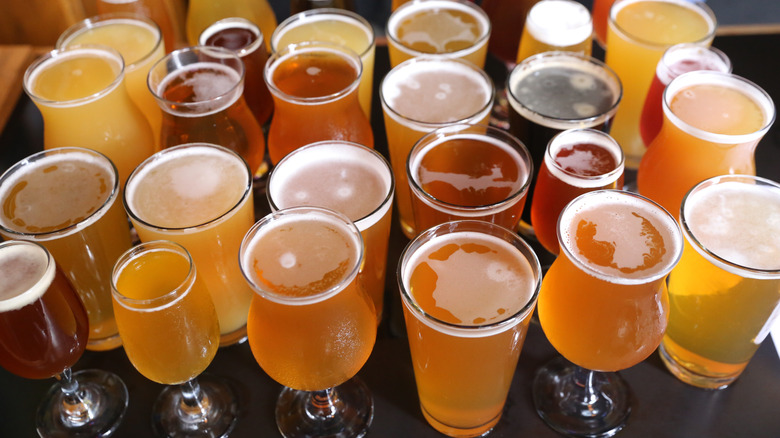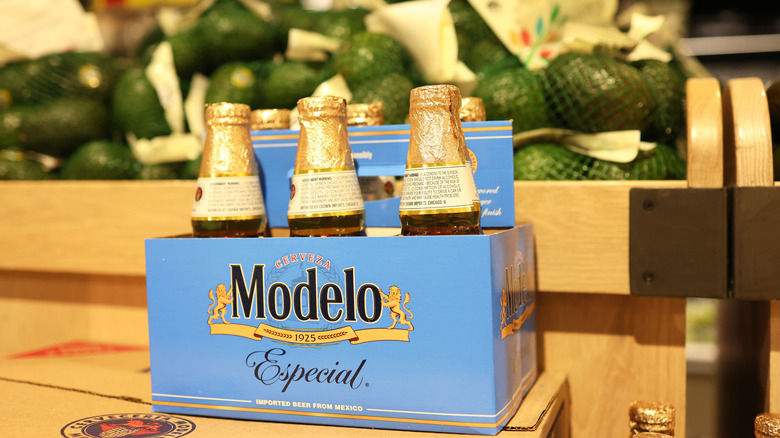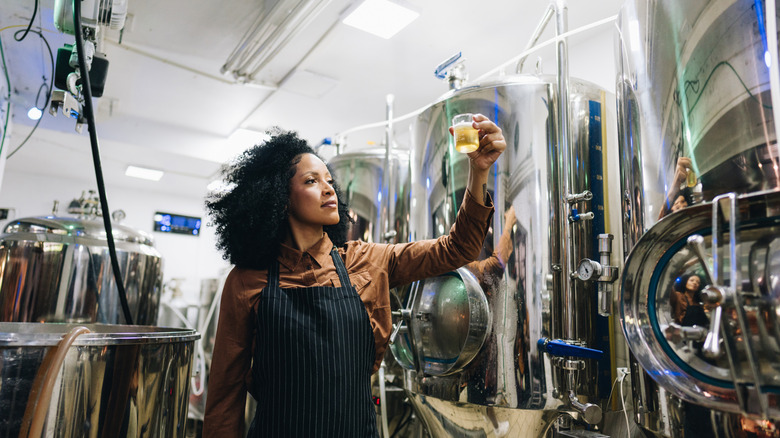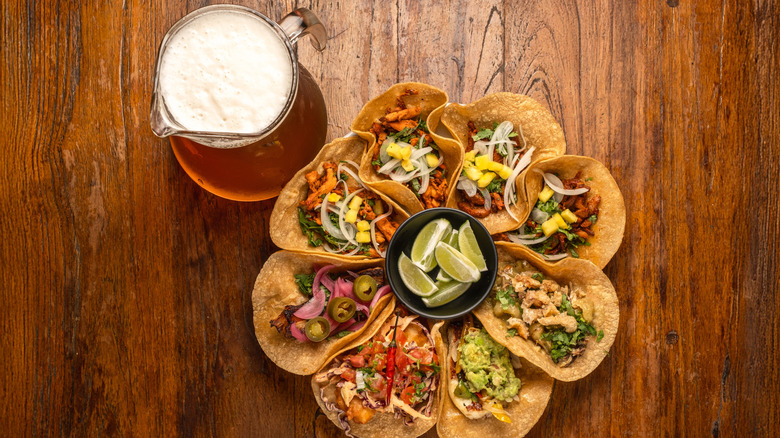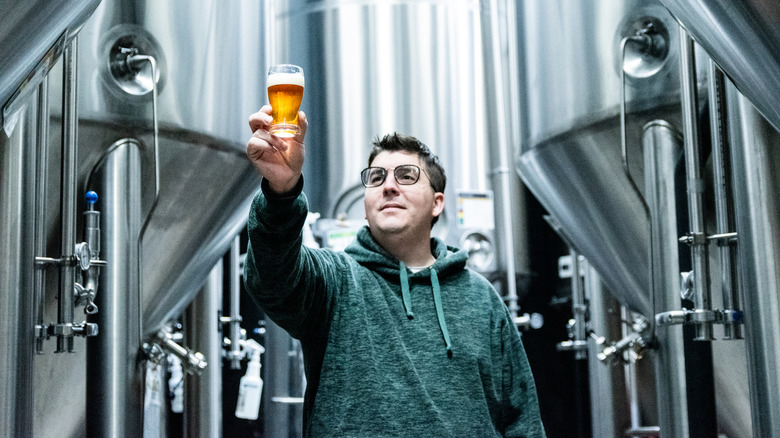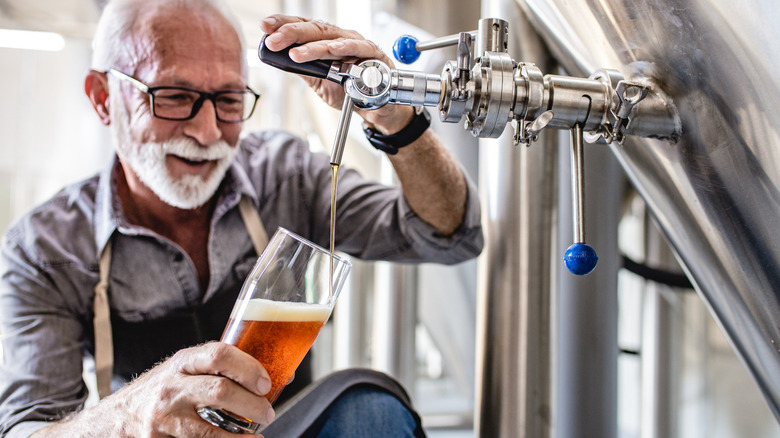Mexican Vs American Lager: What's The Difference?
There are so many different types of beer, and being presented with a long list of them at a bar or store can make a simplistic lager look pretty attractive. Lagers may not be as simple as you think, though, and the easy drinking brew is a popular beer variety that can be crafted in an American and Mexican style. We spoke to three master brewers who have ample experience in brewing both American and Mexican lagers to discover just what the difference is between the two.
Though some beer drinkers and even master brewers don't find much difference between American and Mexican lagers, the two styles have some contrasts even in more mainstream brands. Craft beer is so much more than just IPAs and beers with more intense flavor profiles, though, and lagers have made themselves known in the craft brewing space. Differences in craft lager styles may be even more pronounced than those of the mass produced beers. Our three experts all create lagers in craft breweries with taste and drinking experience in mind, and here's what they had to say about the differences between the easy drinking beer's variants.
Mexican lagers tend to be more complex in flavor
The appeal of a lager for many is its mild flavor and easy-drinking characteristics, but this factor is also one of the main differences between American and Mexican lagers. According to Jess Fierro, the impressive woman behind Atrevida Beer Co., it's the American lagers that have that signature lightness: "American lagers are typically light, crisp, and refreshing. They have a mild flavor profile with very subtle malt sweetness and low bittering hop finish."
Fierro explained that Mexican lagers, on the other hand, are more flavorful on the tongue, saying, "Mexican lagers exhibit a slightly more complex flavor profile. They typically have a bit more malt sweetness accompanied by a hint of corn or rice." It's not only this sweet and grainy flavor difference, though. Fierro also noted a hint of bitterness in a Mexican lager that American lagers tend to steer clear of.
This flavor deviation is subtle, and nowhere near the difference between lagers and ales or any other popular type of beer. Those who enjoy a lager regularly, though, will likely be able to pick up on these small variations.
American lagers can utilize different varieties of hops
Hops are used in the making of pretty much every kind of beer, and hops are what give beer a bitterness. Using different types of hops will contribute different flavors and levels of bitterness to the beer. As an easy going beer type, lagers naturally use less hops than bolder beer variations. While American and Mexican lagers share this subtle use of hops, the difference in hop varieties used in the two regional styles of lager have a direct effect on their slight variance in bitterness.
According to Jess Fierro, American lagers have an IBU of 10 to 20, which is almost as low as you can get on this bitterness scale. Mexican lagers typically fall in this range as well, but Fierro revealed that they can exceed it. She also mentioned that the hops used in Mexican lagers tend to create a brew that encourages the bitterness to complement other tastes that are present. "Mexican lagers may use hops that impart a slightly more pronounced flavor, providing a balance to the sweetness," she explained.
American lagers can utilize hops of a different flavor profile than Mexican lagers
Using different varieties and amounts of hops contributes to different levels of bitterness in a brew, but hops play an even more important role in the taste of beer. The very profile of a beer can be dependent on which hops are used in the brewing process. In a lot of cases, this is another characteristic in which American lagers and Mexican lagers can differ ever so slightly.
According to Jess Fierro, American lagers can be expected to use hops that leave a light and fresh taste. "American lagers generally use hops that contribute mild bitterness and subtle floral or grassy notes," the master brewer explained. The underlying taste of Mexican lagers is a bit different and perhaps speaks more to its regional flavors. According to Fierro, these lagers are more earthy and spiced, much like some of the ingredients behind Latin food: "Some Mexican lagers can have herbal or spicy hop notes, adding complexity."
While these variations of flavor profiles can have distinct differences to the trained taste bud, they can also overlap. Herbal and floral flavor profiles are complementary, and depending on the specific flavor note, can be one and the same. However subtle the distinction, it may be the push a lager lover needs to prefer one beer over another.
American lagers can have a lighter, more subdued texture
Taste is obviously the defining characteristic of beer for most, but there are other traits of a beer that affect its overall drinking experience. Beer is much like wine in this way, especially when taking into consideration the mouthfeel of a brew. According to Puesto master brewer Doug Hasker, Mexican lagers come out superior when it comes to mouthfeel. "American lagers tend to have a lighter grainy texture," he said. "This makes the American lagers a little less interesting, in my opinion."
This doesn't discount the validity of American lagers, of course. The lack of grain present in these brews speak to the smoothness and drinkability that lagers are so known for. The increased texture in Mexican lagers makes them a slightly more bold and complex version of the lagers you may be more used to drinking.
If you're someone who chugs beer or does so mechanically, try slowing it down. Assessing the mouthfeel of a beer is necessary to truly appreciate its brewing, and that can't be done unless you allow the beer to coat the inside of your mouth. Take a page out of a sommelier's book and swish a mouthful of beer, you may be able to taste your lager more deeply.
Mexican lagers are still growing in popularity
American lagers have been on the top of the beer chain for some time, the light and easy drinking qualities being attractive to a large range of people. According to Doug Hasker, though, Mexican lagers are having a very serious moment. "Until recently, Budweiser was the largest-selling beer in the world, recently overtaken by Modelo, a Mexican lager," he said. Though he attributed a good deal of this to the beer's mainstream distributor, he also gave credit where it's due. "It is a huge statement that the consumer is looking for slightly more flavor."
Jess Fierro has seen an increase in interest for Mexican lagers in the world of craft beer as well. She exclusively told Mashed: "Mexican lagers hold a prominent and growing position in the contemporary beer scene. They have carved out a significant niche in the market." Head brewer of Common Space Brewery, Andy Link, agreed that more recently some areas of the United States favor a lager brewed in Mexico, stating, "There are areas of the United States where lagers imported from Mexico are more popular, and other areas of the United States where domestic lagers are more popular." Link attributed this to demographics in certain areas, and it would make sense that different regions get a taste for a certain type of brew. The craft beer scene has exploded in recent years, which would link to an increased demand for slightly more flavorful lagers.
Mexican lagers can appear a shade darker than their American counterparts
Beer can range in color from a very light gold to an almost black, inky shade. Lagers fall to the lighter side of the shade scale, but it's sometimes possible to see a difference in color between American and Mexican lagers. Jess Fierro attributes a slightly darker shade to some Mexican lagers, and told Mashed that these brews are more likely to use ingredients that result in a warmer color. As she put it, "Mexican lagers tend to have a similar pale gold hue, but occasionally appear a bit darker, depending on the specific malts and adjuncts used." Conversely, Fierro claimed brewers use pale malts for American style lagers.
Of course, the distinction between the two styles of lagers cannot be made from color alone. Mainstream Mexican lagers, like Modela and Corona, are just as light in color as the lightest American lagers. Lagers that are brewed in such a way they end up much darker than a light amber, usually fall into a new classification. Amber lagers and dark lagers exist, but you'll find less differences between pilsners and traditional lagers than you will their darker counterparts.
American lagers can smell different than Mexican lagers
It may seem absurd to liken beer to wine, but really the two can be fully enjoyed in a similar way. Aroma is one of the defining features of beer, even if you don't stick your nose in your beer mug the same way you do a wine glass. The smell of a brew does contribute to the overall flavor, though, and quite a lot goes into what makes up a beer's particular aroma.
American and Mexican lagers can have very different aromas to the trained nose. Again, master brewer Jess Fierro talked up the increased complexity that can be present in a Mexican lager, saying, "Typically, the American lager has a light aroma featuring subtle malt, sweetness, a touch of hops, and very little complexity. While the Mexican lager can have a sweeter aroma due to the use of adjuncts and present hints of corn, and floral notes from hops or even a slightly spicy character." In this way, Mexican brews give those who enjoy lagers a bit of something extra in every sip.
Mexican lagers utilize corn more than American lagers
When it comes down to the brewing process for American and Mexican lagers, there really isn't a substantial difference. Some brewers, like our expert Andy Link, see Mexican and American lagers as much the same for this reason in particular. Doug Hasker is in agreement, but does note a preference for using more corn when brewing Mexican lagers. According to Hasker, "The larger picture is that there are very few technical differences in the process, aside from using more corn as a fermentable ingredient in the Mexican lagers."
Now, corn is a popular ingredient in lagers, no matter where or in what style they are made. The use of corn is more prevalent in Mexican lagers, though, both traditionally and currently. Quite a lot of Mexican lagers are going to be corn based and sometimes even use more of it while brewing. It's more of a mixed bag with American lagers. Some popular American lagers, like Budweiser, use rice, while others, like Busch, use corn.
American lagers and Mexican lagers pair well with different foods
Generally, beer and food go hand-in-hand, and a lager's mild nature makes for flexibility when pairing with food. Beer lovers can pair an American or Mexican lager with almost anything and be content, but Mexican lagers may have a step up on American lagers when it comes to Latin dishes. This is something Doug Hasker and Jess Fierro agreed on, with Hasker stating, "Mexican lagers tend to be a touch more malty and complement other flavors better. When it comes down to it, all beer pairs well with tacos, Mexican beer perhaps just a little better."
Fierro focused more on the flavors complemented by Mexican lagers, saying, "Spicy and more flavorful dishes typically pair best with Mexican lagers. The subtle sweetness of this style balances the spiciness and thirst quenching attribute. Think, chips and salsa." As far as American lagers go, Fierro suggested foodies pair the light and crisp brews with fresh and fatty foods, like salmon.
Beer makes for a great food pairing, sure, but cooking with beer can bring dishes to new heights. The logic is similar here, though, in using the more complex Mexican lagers to cook dishes with spice. American lagers can again be used to balance out buttery ingredients.
Mexican lagers hold a different place in beer culture than American lagers do
When you think of beer culture in America, you probably either picture tailgating and high energy sporting events, or the more down-to-earth craft brewery scene. According to Jess Fierro, American lagers are very much in line with this, plus a sense of nostalgia for family cookouts and camping. When it comes to culture around Mexican lagers, though, it's more in tune with the experience of craft beer drinkers. As Fierro put it, "(Mexican lagers) showcase regional traditions and ingredients, providing a diversity of flavors and styles. This broad spectrum allows consumers to explore different profiles and cultural influences within the lager category."
The more modern approach to beer culture, pretty much everywhere, is to prioritize local breweries. The craft scene has its hold on beer drinkers, and it seems here to stay. Master brewer Andy Link explained preference for American and locally crafted lagers by Americans to boil down to freshness. "Flavor and aroma fade with time and harsh conditions," he said. "The process of importation can be long, arduous, and rough on something as delicate as a lighter beer!" With the uptick in craft breweries, beer culture seems to have shifted to expect higher quality and freshness from beer, which is another reason American craft lagers may be more popular domestically.
American lagers are brewed with treated water
One thing some beer companies may not want you to know is how the water is manipulated for beer brewing. While some companies will add salts and minerals to the water, the level of treatment of the water also differs depending on where it was brewed. Doug Hasker told Mashed that the big difference between beer crafting in Mexico to that of America is that state of the water at the brewery. "Most Mexican craft beer breweries do not treat their water, but the major breweries do," he says.
Typically, water will be treated to soften the water, remove unwanted minerals, or to simply clean it. Steam boilers can be used to treat water, and a lot of breweries use reverse osmosis to filter water as well. These treatments of the water are not inconsequential to the brew, according to Hasker. He claims this treatment process makes a better beer.
Mexican lagers can have a little extra love added in the brewing process
Beer brewing isn't particularly seen as a cute endeavor, but Doug Hasker has an endearing method of brewing his Mexican lagers. When asked about how his brewing process differed from American to Mexican lagers, the Puesto master brewer revealed he speaks some love into his brews. "When I brew Mexican lagers in our brewery," he said, "I tend to speak Spanish around the brew and tell it I love it throughout the day. I don't do that with the American beers."
Hasker is known as the "King of Lagers" in the San Diego area, and this adoration for beer making may be one reason why. They say food cooked with love tastes better, and we can imagine it's exactly the same for beer. Filling the brewing vat up with Spanish-spoken words of love is something that just seems right for a Mexican lager. It's not just love that's added, but a bit of the Latin culture as well. Though it makes sense why American lagers don't receive this same treatment, the murmurs of devotion in Spanish is a much appreciated ingredient for a Mexican lager brewed in America.
